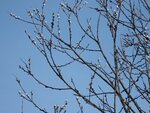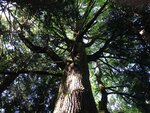

It’s the lucky person who has childhood memories of time spent in a tree. In our family, it was a crabapple tree in the backyard that was easy to climb and a great place to disappear and read a book. And this tree had a special bonus: when the crabapples ripened in midsummer, neighborhood grandmas would pay us 50 cents a bucket for them, provided we picked carefully and didn’t bruise the fruit. They made delicious crabapple jelly that was a clear, brilliant magenta.
So, when I grew up, I planted two semi-dwarf crabapple trees in the parking strip in front of my house. Semi-dwarf seemed like a good idea because there are power lines overhead. When they bloomed, neighbors inhaled happily, and when small bright crabapples appeared in the summer, they asked what they were. The trees continued to seem like a good idea for about a dozen years.
But then . . . semi-dwarf stopped being either semi or dwarf. By their sweet 16, the trees were up in the power lines. And every summer, the deluge of crabapples got bigger. By this time, everyone I knew had several years’ supply of crabapple jelly, and I couldn’t give crabapples away. I took a big box to the Farmers Market, and they couldn’t give them away either. The sad news is that most Farmers Market shoppers don’t know what crabapples are and have never seen or tasted crabapple jelly.
Soon, the relentless downpour of little apples became an annual pedestrian hazard, requiring twice-daily sidewalk sweeping. So, about twenty years after planting, both trees had to be taken down. It was a sad loss.
Planting fruit trees that get too big and bear too much seems to be a very common failing. Every summer, my neighborhood is dotted with overgrown apple and pear trees whose fruit mostly rots on the ground.
When it comes to planting trees, there are many other possible mistakes, too.
Here’s the biggest one: plant hundreds – maybe even thousands – of trees of the same species only to find they’re susceptible to a fatal, rampant disease or insect infestation. Municipal plantings of elms come to mind. Some varieties were thought to be immune from the dreaded Dutch elm disease; now it turns out they’re not. Treating them with pesticides is expensive, only marginally effective, and toxic to other life forms. Replacing them will be even more expensive.
Another mistake is not thinking about how long trees will live. That’s a common cause of conflict about public plantings of flowering cherry trees. Many varieties have a lifespan of just 20-30 years, so people are often shocked and outraged to see their beloved trees being taken out and replaced. (There are a few varieties that live up to 80 years or so, but of course, that also depends on where they are planted.)
Size matters, too. Trees get bigger faster than we expect. Time also passes faster than we expect. In ten years, a small sapling turns into a tall, rangy teenager; in another ten years, its branches are taller than the roof. A too-big tree can be a difficult mistake to fix, especially if you wait too long. I witnessed one mistake across the street: A former neighbor planted a Douglas Fir in a narrow space between two houses and let it grow for 20 years.
In spite of all our mistakes, as you can see out most any window, plenty of trees are thriving. Some we planted; far more came up without any human help. When spring comes and deciduous trees leaf out, most of our tree-planting mistakes will seem inconsequential, at least for a while. Magnolias in full flower will beguile us into thinking we live in a perfect world.
So why all this talk of tree mistakes when there is so much more success than failure?
It’s because in a time of climate change, success among trees is more highly valued, and failure is more deeply regretted. Every living tree is a friend of our future, and we need all the friends we can get.
Jill Severn writes from her home in Olympia, where she grows vegetables, flowers, and a small flock of chickens. She loves conversation among gardeners. Start one by emailing her at jill@theJOLTnews.com
1 comment on this item Please log in to comment by clicking here
GinnyAnn
You forgot to mention another tree mistake when planting trees in parking strips: roots that tear up the sidewalk and grow down into the sewer/water lines. I'm a tree-hugger and would love to have all our countryside retain as many big fat trees as possible. However, people don't factor in the size of mature trees when planting them for decorative landscaping. Your own story about crabapples is a perfect example of one kind of learning by trial and error. Tripping over broken sidewalks in downtown Olympia is another example of tree mistakes. I prefer to keep lovely trees and widen the open space to walk around them if we can.
Saturday, January 27 Report this